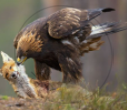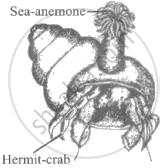Advertisements
Advertisements
प्रश्न
Explain parasitism.
Define the following term:
Parasitism
उत्तर
Parasitism is generally defined as a relationship between the two living species in which one organism is benefitted at the expense of the other. The organism that is benefitted is called the parasite, while the one that is harmed is called the host.
संबंधित प्रश्न
Give one example of Interspecific competition.
Give one example for Mutualism
Name important defense mechanisms in plants against herbivores.
What is population ecology?
What is Mortality? What are its two types?
Define the term population interactions. State its two types.
Define mutualism.
What is Commensalism? Explain it with suitable example.
Define population growth. Explain different types of age pyramids.
The interaction in nature, where one gets to benefit on the expense of other is _________.
Match the following and choose the correct combination from the options given below.
| Column I | Column II |
| Mutualism | Lion and deer |
| Commensalism | Round worm and man |
| Parasitism | Birds compete with squirrels for nuts |
| Competition | Sea anemone on hermit crab |
| Predation | Barnacles attached to Whales |
Mutualism can be represented as the interaction between ____________.
Identify the interspecific interaction depicted in the following figure.

Brood parasitism is best explained by the example of ____________.
The interspecific interaction between Cuckoo and Crow is ______
Mycorrhizae are the example of ______.
Which of the following is not an example of commensalism?
An interaction favourable to both population but no obligatory to either is ______.
Which type of interaction is represented by the given figure?
A population has more young individuals compared to the older individuals. What would be the status of the population after some years?
Which of the following is a partial root parasite?
What are the organisms that feed on plant sap and other plant parts called?
Give one example for the following type.
Phytophagous animal
Fill in the blanks
| Species A | Species B | Type of Interaction | Example |
| + | - | ______ | ______ |
| + | + | ______ | ______ |
| + | 0 | Commensalism | ______ |
Give one example for the following:
An organism which can conform
Match the Column I with Column II.
| Column I | Column II |
| A. Lichen | (i) Commensalism |
| B. Shark and Pilot fish | (ii) Mutualism |
| C. Barnacles on the back of a whale | (iii) Symbiotic obligatory relationship |
| D. Sharks and dolphins | (iv) Competition |
Complete the following chart regarding population interaction and re-write:
| Sr. No. | Name of interaction | Interaction between |
| 1. | ? | Plasmodium and Man |
| 2. | ? | Leopard and Lion |
| 3. | ? | Clownfish and Sea-anemone |
The diagram given below shows the life cycle of a malarial parasite. Study it carefully and answer the questions that follows:

- Name the hosts in which the asexual phase and sexual phase of the life cycle takes place.
- Identify the infective stage labelled ‘D’.
- Name the structure labelled ‘A’ and ‘E’.
- Give any one symptom of malaria.
What happens to an inferior competitor if a superior competitor is present in the same environment?
